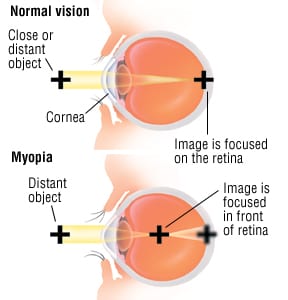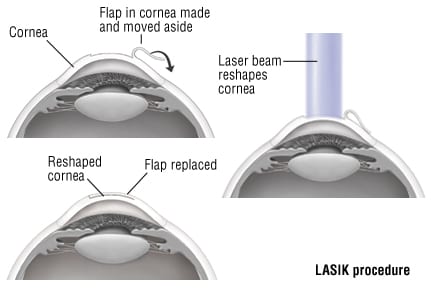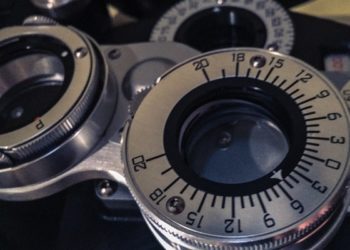Patient Basics: Nearsightedness (Myopia)
Originally published by Harvard Health.
What Is It?
A person who is nearsighted has difficulty seeing objects in the distance, although he or she can see close objects well. Nearsightedness is also called myopia.
In some cases, nearsightedness is an inherited condition caused by an abnormally long eye, as measured from front to back. Because there is a longer distance between the cornea (the clear “window” that covers the front of the eye) and the retina (the light-sensitive layer at the back of the eye), images tend to focus in front of the retina, rather than on the retina itself.
In other cases, nearsightedness is the result of a mismatch between the length of the eye and the ability of the eye’s lens to focus an image in the correct location. Again, this causes images to focus in front of the retina, resulting in nearsightedness.
Currently, nearsightedness is the most common form of vision problem in the United States, affecting an estimated 25% of Americans. In many cases, genetic factors play a role in the condition. Several generations of the same family can have the problem.
Symptoms
Symptoms of nearsightedness can include:
- Difficulty seeing distant objects, such as when watching television or a movie or when trying to read a billboard, a traffic sign or a teacher’s notes on a chalkboard
- Squinting
- Headaches triggered by squinting
- Poor school performance, which is often the first clue in young children, who rarely complain about vision problems
Diagnosis
After reviewing your symptoms, the doctor will examine your eyes, and test how well you can see.
To measure vision, doctors use a ratio in which the top number represents the patient’s vision, and the bottom number represents the vision of someone who sees perfectly. For example, a person is said to have 20/20 vision if he or she can see at 20 feet what a person with perfect vision is expected to see at 20 feet. On the other hand, a mildly nearsighted person may see at 20 feet what a person with perfect vision can see at 30 feet. This is called 20/30 vision. A more severely nearsighted person might have a ratio of 20/40 or 20/100.
In older children and adults, visual acuity often is measured by having the person read letters from an eye chart on the wall. A hand-held chart is also available. However, since this type of chart is held close to the patient, a nearsighted person may have less difficulty seeing it. In young children and people who cannot read, the doctor can use alternative charts that display objects, animals or the capital “E” facing in different directions.
Expected Duration
Nearsightedness is a long-term condition that usually stops getting worse once a person reaches his or her 20s.
Prevention
In most cases, nearsightedness is related to inherited factors that cannot be prevented.
Treatment
If you are nearsighted, your doctor will probably prescribe eyeglasses or contact lenses to correct the problem. These lenses are thin in the center and thick around the edges, which focuses the viewed image on the retina.
Many cases of nearsightedness can be corrected with eye surgery. Surgery improves the eye’s focus by flattening or reshaping the central part of the cornea. Procedures used, from most common to least common, are:
- LASIK (laser in situ keratomileusis) — A surgeon uses a tiny knife to slice into the cornea from the side. Next, a laser is used to remove a precise amount of corneal tissue from beneath the sliced area. This flattens the cornea and improves the eye’s focus.
- Photorefractive keratotomy (PRK) — A laser beam is used to remove tissue from the outer surface of the cornea. This reshapes the cornea and improves the eye’s focus.
- Radial keratotomy (RK) — After the eye is numbed (anesthetized), tiny cuts are made in the edges of the cornea. This causes the central portion of the cornea to flatten, improving the eye’s focus.
- Placing an artificial lens inside the eye — A lens to correct the myopia can be placed inside the eye in front of the normal lens. This is usually reserved for cases of extremely high myopia. Such cases are not as easily treated by corneal surgery.
LASIK and PRK surgery have almost completely replaced radial keratotomy. People choose LASIK more than PRK because it offers excellent results, is a fast procedure, and recovery is painless.
Although the U.S. Food and Drug Administration (FDA) has approved several types of lasers for the surgical treatment of nearsightedness, not every nearsighted person is a good candidate for this treatment. In general, laser procedures are not done on people who are under age 21 because their eyes have not finished growing.
When To Call a Professional
Make an appointment to see your primary care doctor or an ophthalmologist (a doctor who specializes in eye problems) if your vision blurs when you look at distant objects. In particular, call your doctor if blurry vision interferes with your job, school work or ability to drive safely.
Call your pediatrician if your child complains about blurry vision, has difficulty seeing the chalkboard at school, squints while looking at distant objects or complains of frequent headaches. Always make sure that the doctor checks your child’s eyes at every routine physical examination or well-baby visit. More formalized visual testing should be done between ages 3 and 4, and then again at the start of school.
Prognosis
Eyeglasses and contact lenses can correct most cases of nearsightedness.
The long-term effects of laser eye surgery are still being evaluated. Many patients report that they are very satisfied with laser eye surgery. More than 100,000 laser eye procedures are done successfully each year in the United States. However, as with other forms of surgery, you should understand the risks and benefits before having the procedure.
Additional Info
National Eye Institute
2020 Vision Place
Bethesda, MD 20892-3655
Phone: 301-496-5248
http://www.nei.nih.gov/
American Academy of Ophthalmology
P.O. Box 7424
San Francisco, CA 94120-7424
Phone: 415-561-8500
Fax: 415-561-8533
http://www.aao.org/
American Academy of Pediatrics (AAP)
141 Northwest Point Blvd.
Elk Grove Village, IL 60007-1098
Phone: 847-434-4000
Fax: 847-434-8000
http://www.aap.org/
American Society of Cataract and Refractive Surgery/American Society of Ophthalmic Administrators
4000 Legato Road
Suite 850
Fairfax, Virginia 22033
Phone: 703-591-2220
Toll-Free: 1-888-949-6753
Fax: 703-591-0614
U.S. Food and Drug Administration (FDA)
5600 Fishers Lane
Rockville, MD 20857
Toll-Free: 1-888-463-6332
http://www.fda.gov/




